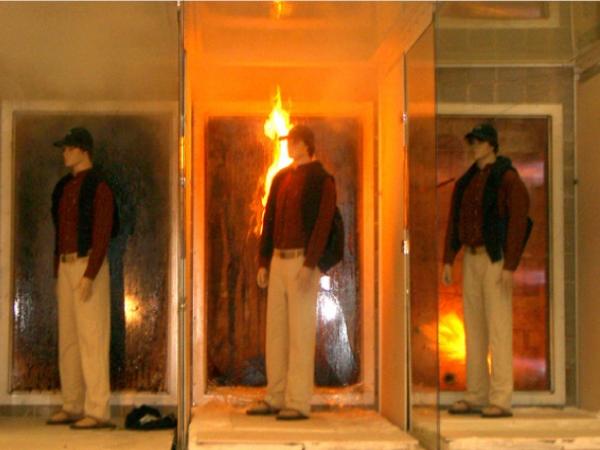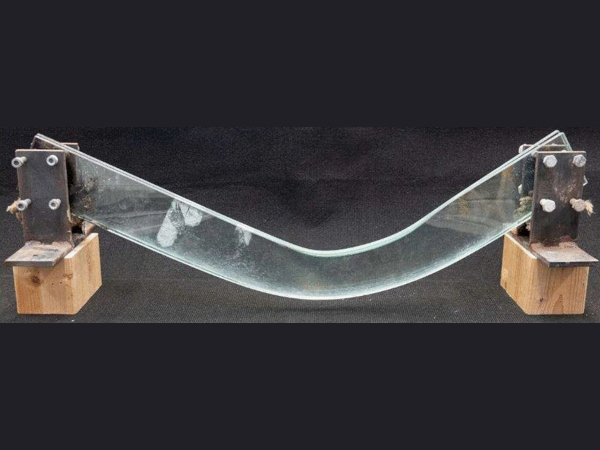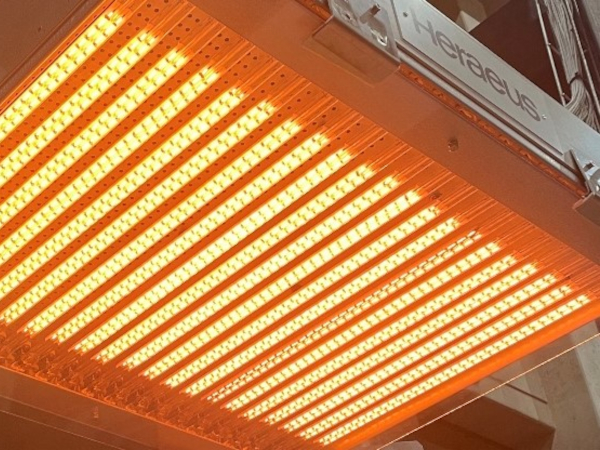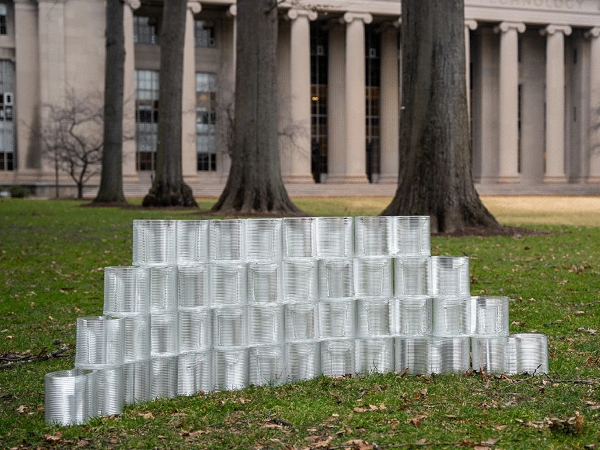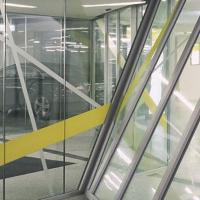For example, the results of a side-by-side, time-to-failure test of fire-protective glazing and fire-resistive glazing conducted in September 2005 at the IFT&S laboratory in Berne, Switzerland and supervised by International Fire Consultants, Ltd sharply contrast the differences between the two:
Within 20 minutes of furnace exposure
- Fire-protective glazing: radiant heat flux reaches “critical intensity” within the test chamber
- Fire-resistive glazing: no observed changes in the test chamber
Within 27 minutes of furnace exposure
- Fire-protective glazing: auto-ignition commences; several objects begin to burn in the test chamber
- Fire-resistive glazing: no observed changes
Within 45 minutes of furnace exposure
- Fire-protective glazing: spontaneous combustion from radiant heat transmission throughout the test chamber
- Fire-resistive glazing: no observed changes (a technician safely enters the chamber to demonstrate the hazard-free environment)
This time-to-failure test presents the hazards of radiant heat transmission as well as the stopping power of fire-resistive glass.
A subsequent third-party test conducted in March 2006 at the Intertek Testing Services center subjected three types of fire protective glazing products wired glass, ceramic glass, and heat-reflective specialty tempered glass to the same ASTM E-119 test.
Mannequins were placed on the non-fire side to see the effect of radiant heat on clothing and other combustible items.
Within 10 minutes
- The mannequins in the ceramic and wired glass chambers began to smoke at 5 minutes
- The mannequin in the wired glass chamber is auto-ignited by radiant heat at 8:55 minutes
At 12 minutes
- The mannequin in the ceramic changer is auto-ignited by radiant heat at 12:15 minutes
At 16 minutes
- The mannequin in the heat-reflective specialty tempered chamber is auto-ignited by radiant heat at 16:15 minutes.
To view the short video of the mannequin test, click here.

To measure radiant heat flux on a glass ceramic panel a common fire-protective glazing material another third-party test was conducted in April 2016 at the Intertek Testing Services Center.
The ceramic panel was tested in accordance with UL 9 voluntary heat flux testing procedures. A radiometer was positioned one meter from the center of the test panel to monitor radiant heat flux. Results:
Within 5 minutes
- The radiometer measures slightly more than 5 kW/m2 of radiant heat flux (FEMA published guidelines state 5 kW/m2 results in severe skin pain within 4 seconds and eye damage)
- Glass ceramic surface temperature of 667° F
Within 10 minutes
- Radiant heat flux triples to 15 kW/m2
- Glass ceramic surface temperature of 970° F
Within 30 minutes
- Radiant heat flux reaches 20 kW/m2
- Glass ceramic surface temperature of 1050° F
The 2012 AND 2015 International Building Code severely limits fire protection products like glass ceramic in doors and wall assemblies.
The rapid, uncontrolled transmission of deadly radiant heat makes them a concern to public safety, as shown by the combusting mannequin and the rising surface temperatures in the tests. To see how IBC limits glass ceramic size, look here.
Fire-Resistive Glass
Fire-resistive glazing blocks fire and smoke passage (just as fire-protected glazing does) while it minimizes lethal radiant heat transmission, in accordance with ASTM E-119. That’s a critical distinction in today’s build environment, where architects place a growing emphasis on natural light and outside exposure through expansive glass walls and doorways.
The challenge for code officials is to understand the 60/90/120/180 minute claims of some fire-rated glass manufacturers are heavily qualified by code, with material size strictly limited.
For example, 60/90/180 minute doors cannot exceed 100 square inches of ceramic glazing just a 10-inch by 10-inch transparent portal. Designers seeking a more open, transparent aesthetic must look beyond ceramic glass.
Growing Design Solution
Now that architects are doing more and more with glass design, pressure is growing to specify more fire-resistive glass.
Robert Davidson, a former fire marshal, knows from firsthand experience about the power of radiant heat.
Davidson recalls from his firefighting days that, “If a building was on fire and close to another building, we used to create a curtain wall of water between the buildings, thinking that would somehow stop the fire from spreading. It didn’t. The building next door would catch fire anyway because the radiant heat would pass right through the water.”
Davidson also cautions the remarkable ability of ceramic to transfer radiant heat should not be underestimated. He points to ceramic stovetops as an example. “Ceramic is used on stovetops because of its rapid heat transfer. Is that how we want our buildings to behave during a fire? Fire-resistive glass can save lives without compromising an architect’s design vision.”
Learn More
For code officials wishing to investigate the matter in greater detail, a number of resources are available. To review videos of time-to-failure tests and other materials about fire-rated glass, click here and visit Resources at: safti.com.
The views and opinions expressed in this article are those of the sponsor and do not necessarily reflect those of the International Code Council, or Hanley Wood.
i See Tables 716.5 (Opening Fire Protection Assemblies, Ratings and Markings) and 716.6 (Fire Window Assembly Fire Protection Ratings) in the 2012 and 2015 IBC.
ii See Tables 716.5 (Opening Fire Protection Assemblies, Ratings and Markings) and 716.6 (Fire Window Assembly Fire Protection Ratings) in the 2012 and 2015 IBC.

